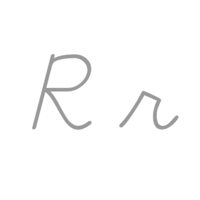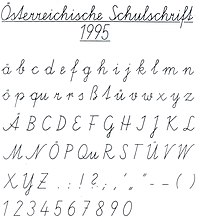R.
R or r (pronounced: [ ʔɛr ], [ ʔɛʀ ] or [ ʔɛʁ ], imprecisely also [ ʔɛɐ̯ ]) is the 18th letter of the modern Latin alphabet . In most of the spelling in Latin , it denotes a consonant from the group of liquids . The R has an average frequency of 7.00% in German texts, making it the fifth most common letter .

The finger alphabet for the deaf or hard of hearing represents the letter R with the crossed index and middle fingers pointing upwards and the other fingers resting on the palm of the hand. The thumb rests on the fingers pointing downwards.
origin
|
|

|

|
|
|

|
| Human head (protosinaitic) | Phoenician Resh | Greek rho | Etruscan R. | Etruscan R with attachment |
Latin R |

In the Protosinaite script the letter represented the profile of a human head. In the Phoenician alphabet the head was strongly stylized. The letter was given the name Resch (head) and was available to the phonetic value [ r ] .
The Resch was adopted in the Greek alphabet under the name Rho . Over time, the rho was rounded off and with the change in the direction of writing, the letter also changed its orientation. Sometimes the rho was also written with a short approach under the rounding, but this modification was not included in the Greek alphabet.
The Rho was adopted as R in the Etruscan alphabet. The Etruscans also wrote the letter partly with, partly without beginning. When the Romans, the Etruscan alphabet took over, they used the version with approach it from P to distinguish. The approach grew over time and through to Roman antiquity to the base line of the letter. The letter was also mirrored as in Greek, in order to adapt it to the writing direction from left to right. In this form, the R entered the Latin alphabet.
to form

With the development of the Carolingian minuscule , the lowercase letter r with a straight stem was created. The forms used in today's Antiqua fonts are derived from this.
In the Middle Ages, a second form of the lowercase letter was developed, the round r or r rotunda . It was written after round characters like o, d, p, etc.
script
In script fonts , especially in output writings (in education for first graders learned forms of writing), different forms can be found on the country and time period:
French (18th century), rounded stem of the r, but opposite to the round r
German Kurrentschrift until the middle of the 20th century (Switzerland end of the 19th century)
Sütterlin (Germany 1915-1942)
Related letters in other writing systems
In most of the writing systems, which can ultimately be traced back to the Phoenician script , there are letters that, like the R, can be derived from the Phoenician Resch and regularly designate sounds that are also usually designated with the R in the Latin writing system:

|

|

|

|

|
|
|
Hebrew : Resh |
Arabic : Ra |
Greek : Rho |
Cyrillic : he |
Gothic : Reda |
Runes ( Futhark ): Raidho |
Similar letters

In numerous Gothic scripts , the capital letter form of the K resembles that of the R, especially since the two upper arms of the K are connected to form a closed shape. Readers inexperienced in Fraktur can therefore misunderstand a K as an R (e.g. cattle instead of child ). The K differs by an arch attached to the left trunk and the rest of the shape swinging to the right, while the R there mostly has an elephant's trunk swinging down to the left to about half the letter height .
The modern form of the Я of the Cyrillic script (lower case я), pronounced in Russian as / ja / or (after palatalized consonants) / a /, is similar to the mirrored capital letter form of the Latin R, but is not related to the R. The form was created with the font reform of Peter the Great (1708–1710) by adapting the form of the small law (Ѧ, Russian ѭсъ малъ ) to the shape of the classical antiqua . Since the Я is quite common in Russian texts, while the Cyrillic script does not contain a letter that is the same as the non-mirrored R , the R is occasionally mirrored in Latin-written texts that are supposed to evoke associations with Russia or the Soviet Union (for example in a caricature way) .
The Cherokee syllabary characters for "e" (/ e /) and "sv" (/ sə̃ /) are similar to R.
pronunciation
Pronunciation in German
Not wherever the letter R appears in scripture, it is actually pronounced as the phoneme / r /. Most dictionaries that are based on the so-called standard wording of German contain the recommendation to pronounce the letter as / r / after the short vowels i, ä, a, ü, ö, u, o at the end of the word or in front of a Consonants, e.g. B. [vɪr] for “confused” and not [vɪɐ̯] . In other cases, a weakened a [ɐ̯] is usually given, such as “door”, “we” or “mother”.
There are several ways to pronounce the / r / in German: a. Rolled one or more times with the tip of the tongue or generated by rubbing the uvula. Today / r / mostly as a suppository R [ ʁ ] ( voiced uvular fricative or approximant pronounced). Originally, the R sound as "rolled" tongue Spitz According to [ r ] ( voiced alveolar Vibrant spoken). In Bavaria , Franconia , in rural regions of Germany ( East Frisia , Siegerland , Central Hesse ) and Austria as well as a large majority in German-speaking Switzerland (except in their north-east and Basel), this pronunciation still predominates, as in other European countries (except in France, Belgium and Denmark as well as in western Norway and southern Sweden).
Alveolar R was still prevalent in most parts of Germany at the beginning of the 20th century. Today it predominates in the language of the oldest generation of rural speakers, while younger speakers use the uvular R. This applies to large parts of northern Germany, Hesse and Westphalia, among others.
The areas in which only the uvular R occurs in the language of the oldest generation of rural speakers include most of Saxony, Thuringia, Baden-Württemberg (exception: Upper Swabia) and the Rhineland, as well as the greater Berlin area.
A retro flexes ( "English") [ ɻ ] is found in places at German dialects, but practically replaced today everywhere in the language of the younger generation through the uvular R. Examples are western Central Hesse, parts of the Siegerland and Wittgensteiner Land, the Upper Harz and the Silesian dialect that was lost after the Second World War.
Pronunciation in other languages
Most languages do not know the uvular variant of the R. The following European languages know the uvular R either as one of several possible realizations of the phoneme / r / or as the only possible pronunciation:
- French, German, Dutch, Luxembourgish, Yiddish, Danish, Swedish, Norwegian, Sorbian.
In English it occurs in the Northumberland dialect ; this pronunciation is known as the Northumbrian burr . In Italy the uvular R is considered to be Milanese .
Portuguese has two R-phonemes / r / and / rr /. / r / is a simply rolled alveolar vibrant, / rr / can be realized in two ways: as a uvular vibrant / fricative or as a multiple rolled alveolar vibrant.
In Arabic, both classical Arabic and in today's popular languages, both the alveolare / r /, which is to be regarded as the actual / r /, can be found and in the Arabic script ر is reproduced, as well as the uvulare / r /, in Arabic script the غand mostly transcribed as "gh". Both are separate phonemes. In some words both appear, e.g. B. gharb /غرب / 'West' or even collide directly, e.g. B. al-Maghrib /المغرب / 'Morocco', literally "the country / territory of the West."
Note: In Arabic it is not a / R / but a / γ / (i.e. the voiced variant of / x /). The two sounds sound similar, but are not the same.
r in statistical tables
According to DIN 55301 (design of statistical tables), the lower case r , which is placed after a value (number) in a table compartment, stands for "corrected number" as a value-adding symbol, also as a quality indicator (as opposed to value-substituting symbols). This is exactly how the symbol is used in tables of official statistics .
Quote
“ R […], with l, m and n making up the group of liquid (semivocales). [...] his loud is compared to the growling of a dog and he was given the name of the dog's letter, lat. Litera canina, and after that in ICKELSAMER : [...] the r, is a dog's letter, when he looks angrily at the scene and gets mad , so the tongue is trembling. [...] In connection with this, r amplified as an angry loud: the mocking and irritating sign rrr! [...] "
See also
Web links
Individual evidence
- ↑ Duden. Volume 9: Correct and good German. Mannheim 2007, p. 129 ("The pronunciation of r")
- ↑ The Little Duden. Volume 4: German grammar. 3rd revised edition. Mannheim 2004, p. 60, paragraph 46 ("The debate")
- ^ Siebs: German standard language. Berlin 1961, p. 61: "Since the 17th century, in addition to the old German tongue r, the suppository r (ʀ) has become more and more widespread, so that today both forms must be regarded as equal in standard language ..."
- ^ Johann Christoph Gottsched: Complete and Newly Explained German Language Art. Leipzig 1776, p. 34: "... like the r in Latin: it is not pronounced in the throat, but with a trembling tip of the tongue ..."
- ↑ Gerald Stone: Hornjoserbsko-jendźelski słownik. Ludowe nakładnistwo Domowina, Bautzen 2002, p. 11
- ↑ Guidelines for the design of statistical tables for network programming, Working Group Publications of the State Statistical Offices, Wiesbaden 1997, 41 pages, here: page 36.
- ↑ GENESIS-Online database: Explanation of symbols








